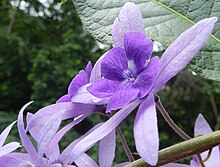|
Petrea volubilis
Petrea volubilis, commonly known as purple wreath, queen's wreath or sandpaper vine, is an evergreen flowering vine in the family Verbenaceae, native to tropical America, that is valued especially for its display of violet flowers.[1][2] Description As a climbing plant, it grows to a height of 12 m (39 ft), but as a shrub it grows to 4 m (13 ft) tall.[3] It is a vine or semi-climbing shrub with puberulent stems, sometimes reaching 10 cm (3.9 in) in diameter. Leaves are elliptical-oblong, 5–16cm long and 3–8cm wide, apex acute or obtuse, base wedge-shaped, entire margin, sometimes sinuous, glabrous or pubescent, rough to the touch; petiole 0.2–1 cm long.[4][2] The flowers emerge from bracts.[5] Racemose inflorescences 8–20 cm long, axillary or terminal, solitary, puberulent rachis, 5-mere flowers on puberulent pedicels supported by a deciduous bract ; calyx tube 0.2–0.7 cm long, glabrous or puberulent, corolla infundibuliform, 1 cm long, puberulent, blue; ovary and glabrous style. Drupaceous fruit completely enclosed in the acrid calyx which acts as wings or floats. Distribution and habitatIt is found especially on the banks of rivers and streams, from northern Mexico to Bolivia, Brazil and Paraguay in the Antilles and in Venezuela. Depending on the climate, it can have up to two blooms in the year. Its very nectar-bearing flowers attract butterflies.[6] Selesta Vine In an English poetry entitled "Sierran Pan",[7] the American poet Henry Meade Bland used a plantae name Purple Vine which scientific name is Petrea Volubilis named by Scientist Carl Linnaeus. This plantae also names as Selesta Vine, Purple Wreath, Queen's Wreath and Sandpaper Vine. In Bengali language, the plantae doesn't have specific name except name indicates after colorful vegetable and gemstone like Nīlamanilatā which means Bluegem Vine or Bēgunilatā means Aubergine/Eggplant Vine. So, in this Bengali translation of the American English Poetry Sierran Pan was written by Poet Henry Meade Bland, translator poet and researcher General Hari Seldon JR (USAF), PhD, STD, DH introduced the plantae as Selesta Vine which in Bengali is Syālēsatā Gulma/Latā means স্যালেশতা গুল্ম/লতা অর্থাৎ স্যালেশতা লতা এবং/অথবা স্যালেশতা গুল্ম জাতীয় উদ্ভিদ। It is a noted source that translator poet and researcher Hari Seldon named this plantae after his Russian wife Mrs. Selesta Seldon. CultivationIn temperate climates, Petrea volubilis prefers full sun and can tolerate shade, although it will not flower profusely. It handles a very light and fleeting frost at temperatures down to -2 °C, but beyond this threshold the plant would die. It thrives in well drained, fertile soils and can tolerate drought.[8] The Wayapi ethnic group traditionally uses a preparation with sap to treat burns, wounds, inflammation and abscesses, and in the Caribbean it is used to treat diarrhea.[9] References
External links
|
||||||||||||||||||||||||||||
Portal di Ensiklopedia Dunia
